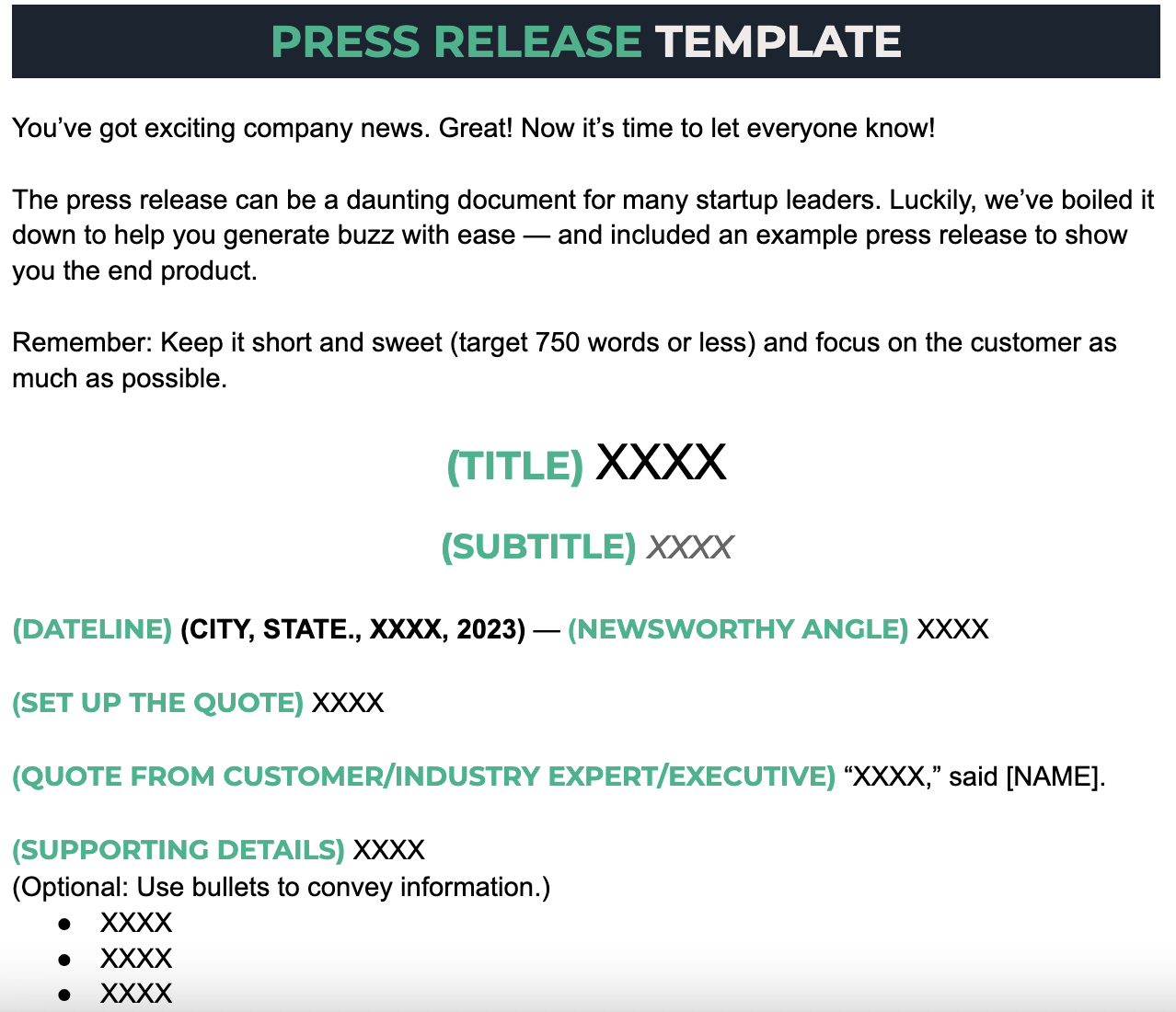It’s easy to write a press release. But it’s never been harder to write a good one that catches people’s attention and secures media coverage in today’s age of information overload.
In the current media environment, there’s a growing chorus of marketers who say press releases no longer matter. And while it’s true that, for most early-stage companies, it’s not realistic to think that media members are waiting around for your next announcement to arrive, there are still plenty of benefits to writing a press release.
It forces you to tell your story in the best possible way. It reinforces the messaging you put out through other channels. And it demonstrates to potential customers and investors that what you’re saying is working. Even if it doesn’t spawn headlines in Forbes or TechCrunch.
Plus, press releases are the most trustworthy form of media, according to Cision. Forty-two percent of people view releases as the most trustworthy, ahead of spokespeople (29%) and company websites (21%).
In this guide, you’ll learn how to write a press release and get access to our press release template to help you start generating some buzz.
Table of Contents
- What Is a Press Release?
- Types of Press Releases
- How to Write A Press Release
- Press Release Distribution Tips
- Press Release Template
What Is a Press Release?
A press release is an official statement produced by an organization that helps inform the public about an announcement or piece of news, with the goal of securing media coverage.
Historically, press releases were distributed directly to media outlets such as newspapers, radio and TV stations and websites. Today, companies can also pay to post their releases to a newswire, which is essentially a feed of releases from companies that media outlets and journalists can easily access. Many companies also publish releases on their own websites and distribute them through their owned channels, such as newsletters and social media.
Types of Press Releases
The most common types of press releases are announcements of:
- new products, features and services
- partnerships
- awards
- new hires
- funding rounds
- company momentum
New Products, Features and Services
If you’re expanding your offering or releasing a brand new one, you’ll want prospective and existing customers to know. Write a press release about how your new offering will help the customer, rather than simply how awesome the new capabilities are.
Partnership
There’s a flywheel effect when two companies join forces. Each company should announce the news at the same time, with their own releases, and each should include a quote from an executive at the other company to show unity. As always, focus on how this partnership benefits your end users.
Awards
Showing off your awards isn’t just a way to toot your own horn; this recognition adds legitimacy to your brand.
Don’t frame your award as a pat on the back. Instead, focus on how the award symbolizes your commitment to the customer. For example, if you win an award for an outstanding product, describe how your product is getting recognition for how much it helps customers. If your CEO is named executive of the year, describe their accomplishment in the context of what they did to further your customer-focused mission.
New Hires
You won’t need to write a press release for every new employee, but highlighting additions to your C-suite and upper-level management is a good practice. Be sure to amplify your new hire’s expertise and experience, and give them an opportunity to share their excitement and vision with a quote.
Funding Announcements
Securing capital from investors is a great accomplishment. Backing from venture capital firms can give your company legitimate name brand recognition and legitimacy in the market.
Your investors will likely share the news as well, meaning funding announcements are a great opportunity to tell your story to a larger audience with a timely hook. Make sure to coordinate with investors and time your release at the round’s close, giving you visibility to all of your investors’ audiences.
A funding press release should specify the reasons why investors chose to work with your company and what you plan to accomplish with your new capital.
Momentum
Sometimes you’ll have a handful of small announcements (company growth, customer wins, etc.) that may not be newsworthy enough on their own. Try writing a press release that combines them and shows your continued momentum.
These releases make great for mid-year and end-of-year updates. It’s helpful to anchor your momentum announcements with tangible numbers and concrete evidence; for example: “We helped Customer X increase revenue by 20%, opened two new office locations and onboarded 50 new customers.”
How to Write a Press Release
To write a press release, follow these steps:
- Write an engaging headline
- Add a dateline
- Lead with a newsworthy angle
- Support your news with details and quotes
- Conclude with a call to action
- Insert your company boilerplate
- Include contact information
It’s important to define your goals before you begin writing, however. Knowing how to write a press release that breaks through all the noise goes beyond following a checklist. And remember — your press release should show how you’re helping customers, rather than serving as a purely self-serving promotional ad.
Take some time to think through the following questions:
- What is our company’s business goal for the release (attract investors, brand building, etc.)?
- What is unique about what we’re announcing (a first-of-it’s kind feature, an impressive statistic, etc.)?
- What’s our target audience?
- Why would this target audience care about this news?
- What is the call to action for the target audience?
- If this is a product announcement, which key features should we highlight?
- What are the three takeaways or messages we want to convey?
1. Write An Engaging Headline
Your audience should be able to read just the title of your release and know what the news is. Statistics are always powerful, so include them if you have any good ones, such as “Businesses See 150% ROI with Product X.”
2. Add a Dateline
List your company’s city, the state and the date (in accordance with your style guide). For example, York IE’s dateline looks like this: Manchester, N.H., Jan. 31, 2023.
3. Lead with a Newsworthy Angle
Time to start the meat of the release! Begin with one sentence that explains what the news is and why people should care. Besides the headline, this is your best chance to capture people’s attention.
4. Support Your News with Details and Quotes
After hooking readers with your introduction, your second paragraph is your chance to expand, clarify and add context. What problem does this news address? What industry trend are you responding to?
Then move on to your first quote, which should ideally be from a customer or partner who’s benefiting from your announcement and can provide third-party validation. But your first quote can also be from a company executive who can bring the announcement to life and explain how the news aligns with your company’s vision, mission and overall messaging.
Avoid cliches such as “We’re so excited…” and “This is a monumental milestone for our company…” Make the quote meaningful and reflective of the speaker’s experience and expertise.
A little secret: not every speaker actually says these things out loud. Oftentimes, you’ll draft a quote for your star witness and simply get their feedback and approval before including it.
Follow the quote up with a couple of paragraphs that help make your announcement more robust and impactful.
You may want to include:
- additional quotes from industry experts, partners or investors;
- additional statistics that add legitimacy to your announcement;
- other recent company news that supports this news.
Be mindful of how you present this information; bullet points are great to increase the skimmability of your release.
5. Conclude with a Call to Action
So you’ve written a great release that has your reader intrigued. Now what? You’ll want to turn that interest into a business opportunity.
Make sure that you nudge the reader toward the next step – contacting you or learning more. Should they click a link to your website to read further? Email your sales@ email address to set up a call? Follow you on LinkedIn for more updates?
Whatever action you’re hoping for, be sure to point them in the right direction.
6. Insert Your Company Boilerplate
At the end of the release, add a short sub-section with your company boilerplate or elevator pitch, which provides a quick overview of what your company does and who you do it for.
7. Include Contact Information
In some cases, a journalist will find your announcement to be worthy of a deeper dive. They’ll need to know who to speak to at your company. Put your public relations contact information here, and try to use a real person, which is better than a generic email.
Press Release Distribution Tips
Writing a press release is only half the battle. How do you make sure people actually see your news? Distribute your release via:
- media pitching
- company website
- social media
You could write the finest press release in the world. If no one reads it, what’s the point? The other half of the battle is distributing the news so that your audience can easily find it.
Very few people — outside of media members — are monitoring a press release wire for news. Meet your audience where they are and break up the content in an easily consumable way. Remember: This exercise is about informing your audience, not just generating clicks on a single press release post.
Here are a few ways to repurpose and distribute your news:
Media Pitching
Proactively pitch your announcement to media outlets before you go live on the wire. A journalist might be interested in expanding on your news, whether in a feature article or trend story.
Sometimes, your pitch will include an offer to share your news with reporters under embargo. This means you agree to give them the news before you announce it publicly, and they agree to wait until the agreed-upon date to publish their coverage. This gives the outlet time to interview sources and prepare stories prior to the launch date.
It’s important to note that you can’t unilaterally declare an embargo. If you send a release to a reporter “under embargo,” but they haven’t agreed to it, they are free to cover the news whenever they want.
You can also pitch a press release as an exclusive, meaning you grant expanded access and an early reporting opportunity to a single news outlet. This incentivizes that publication to cover your story, but it also limits your press options to a single party.
Start by locating a handful of publications, and track down the writers that might be interested. Scout Twitter and LinkedIn, and be sure to cast a wide net; not every journalist will be as excited about your news as you are.
Send a short email that quickly summarizes your announcement and why it would resonate with the publication’s audience. Journalists prefer email pitches that are 100 words or less, but only 13% of pitches are this length, according to Plotlights.
Remember to have realistic expectations. TechCrunch and CrunchBase aren’t going to write about every funding announcement or product launch. Look for relevant news outlets and trade publications that your target audience is likely to visit.
Company Blog
Drumbeat marketing is all about repurposing content on different channels. We suggest posting your news as a blog on the company site. You can copy and paste the initial release, but you might also want to take this opportunity to talk about the news in a different way. Maybe you can tie it back to a thought leadership theme or have an executive write their own deeper dive.
Social Media
As always, your social media accounts are a great way to circulate news. You can link to the release, but don’t count on lots of people clicking on it. Include enough information in your social copy to get the message across on its own.
Press Release Template
A press release template can help you organize your news into a concise, cohesive announcement. Remember to follow the general structure while also making the announcement your own; you want to put your company’s unique perspective on the news.
Writing a press release is a fantastic way to inform investors and prospects, pick up media coverage and build your brand. Remember to focus your release on the benefits of your news to your audience, rather than endlessly patting yourself on the back.
If your company’s doing great things, write a press release to let the world know.








